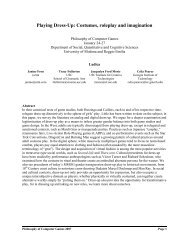The Irreducible Self: Image Studies of First Person
The Irreducible Self: Image Studies of First Person
The Irreducible Self: Image Studies of First Person
You also want an ePaper? Increase the reach of your titles
YUMPU automatically turns print PDFs into web optimized ePapers that Google loves.
2content and its natural surrounding. <strong>The</strong>refore, immersion actually says nothing about themedium, but rather something about the user. And that means that immersion is not anattribute, which can be applied to the game’s design, but rather to the psychological condition<strong>of</strong> the gamer.Nevertheless McMahan provides a hint as to which aspect <strong>of</strong> the game as a pictorial artifact isa necessary precondition for immersion, namely presence. To McMahan, the feeling <strong>of</strong> “beingthere” is only achieved when the virtual space in which the player immerses is presentedartificially. Presence, however, is a central feature <strong>of</strong> images; what images do is presentobjects that only exist on behalf <strong>of</strong> the image. Just as a record can artificially present sound tothe human ear, pictures artificially present things that are only visible to the human eye. But,as opposed to objects <strong>of</strong> the real world, image-objects can only exist or not exist. <strong>The</strong>y cannotbe absent like a person who is not here at the moment. Objects that are presented to a viewerby a picture are either present or they do not exist. In addition, pictures thus do not showthings that are now absent and present somewhere else in the world, but they add new thingsto the world right here and right now.<strong>The</strong> same is true for computer games; they do not show something that is absent, instead theypresent something that has not existed before without being visualized. Video games present avirtual reality. But different from other types <strong>of</strong> images, computer games <strong>of</strong>fer images, whichhave to be used. In my opinion, we must therefore think <strong>of</strong> video games as something thatmust been seen in order to be played. Without that particular performativity a computer gameis not different from a movie or even a photograph.Furthermore, this means that there exists a significant difference even within computer games;on the one hand, there are games that could also be played without a computer, just on paper,such as strategy games or role-playing games. On the other hand there are games that cannotbe played without an image. But, as opposed to photographs, paintings, or even films,computer game pictures are interactive. <strong>The</strong> mode <strong>of</strong> reception <strong>of</strong> a computer game istherefore not contemplation, but rather interaction. And what the player does when he or sheinteracts is actually an interaction with the image, i.e. with the objects presented by thepicture.My proposal at this point is to address these images formally as “simulation” or simulationpictures. <strong>The</strong>re has been an ongoing debate in computer game studies on whether simulationrefers to a certain type <strong>of</strong> computer game or to something that is not a game at all. Chris






